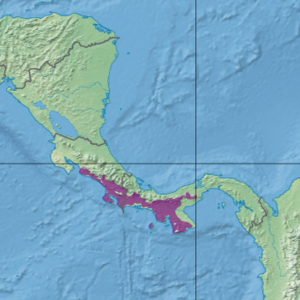Isthmian-Pacific moist forests
The Isthmian-Pacific moist forests ecoregion (WWF ID:NT0130) covers the lowland tropical evergreen forests on the Pacific side of the central mountains of southern Costa Rica and western Panama. As the meeting zone between North and South American floral communities, the area is one of very high biodiversity. Much of the rainforest has, however, been cleared for subsistence agriculture and cattle grazing.[1][2][3]
| Isthmian-Pacific moist forests | |
|---|---|
 Beach in Corcovado National Park, Costa Rica | |
 Ecoregion territory (in purple) | |
| Ecology | |
| Realm | Neotropic |
| Biome | Tropical and subtropical moist broadleaf forests |
| Geography | |
| Area | 29,364 km2 (11,338 sq mi) |
| Coordinates | 8.25°N 81.25°W |
Location and description
The ecoregion is bounded on the west by the Pacific Ocean and on the east by the central mountains of Costa Rica and Panama: the Cordillera Central in Costa Rica at the northern end, extending into Panama as the Cordillera de Talamanca. The mean elevation in the ecoregion is 319 metres (1,047 ft), reaching from sea level to heights of 2,282 metres (7,487 ft).[2] The strip of lowlands runs for 500 km west to east, and typically only 50 km wide. The higher elevations in the mountains to the east are in the Talamancan montane forests ecoregion. The mountains are an active volcanic zone, and most of the soils are derived from the parent basalt bedrock.[3]
Climate
The climate of the ecoregion is Tropical monsoon climate (Köppen climate classification (Am)). This climate is characterized by relatively even temperatures throughout the year (all months being greater than 18 °C (64 °F) average temperature), and a pronounced dry season. The driest month has less than 60 mm of precipitation, but more than (100-(average/25) mm. This climate is mid-way between a tropical rainforest and a tropical savannah. [4][5] Rainfall averages 2,500 mm/year in Panama, higher in Costa Rica.[3]
Flora and fauna
The region is one of high biodiversity, as the area is the meeting zone where North and South American floral and fauna communities mixed when the continents were connected three million years ago.[3] The ecoregion's cover is about one-third closed broadleaf evergreen forest, one-third open forests of various types, and one-third converted to agriculture.[2] Much of the original forest has been disturbed by human activities in the past 100 years, particularly fragmentation of habitat.[3] The region is warmer than most forests to the north, and there are seasonal swamp forests in the lower elevations, grading into mangroves nearest the coast.
While biodiversity of fauna is high (811 different vertebrate taxa have been recorded), endemism in mammals is relatively low. Endemic amphibians include the Airstrip caecilia (Oscaecilia osae), so-called because it is only found near the La Sirena airstrip on the Osa Peninsula, the critically endangered Golfito robber frog (Eleutherodactylus taurus), and the endangered Golfodulcean poison frog (Phyllobates vittatus).[3]
Protected areas
11% of the ecoregion is officially protected.[2] These protected areas include:
References
- "Map of Ecoregions 2017". Resolve, using WWF data. Retrieved September 14, 2019.
- "Isthmian-Pacific moist forests". Digital Observatory for Protected Areas. Retrieved August 1, 2020.
- "Isthmian-Pacific moist forests". The Encyclopedia of Earth. Retrieved August 28, 2020.
- Kottek, M., J. Grieser, C. Beck, B. Rudolf, and F. Rubel, 2006. "World Map of Koppen-Geiger Climate Classification Updated" (PDF). Gebrüder Borntraeger 2006. Retrieved September 14, 2019.CS1 maint: multiple names: authors list (link)
- "Dataset - Koppen climate classifications". World Bank. Retrieved September 14, 2019.